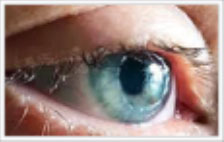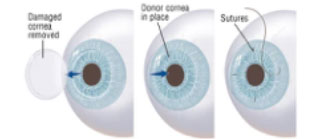
A corneal transplant, also known as keratoplasty, is a surgical procedure to replace damaged or diseased corneal tissue with healthy tissue from a donor. The cornea is the clear, front surface of the eye, and its clarity is crucial for proper light focusing and clear vision. When the cornea is damaged by disease, injury, or scarring, it can cause blurry or distorted vision, and a corneal transplant may be necessary to restore sight.
Eye disease and injuries can damage the cornea. Here are some common eye problems that can lead to a damaged cornea:
Other causes of cataracts include trauma, medications like steroids, systemic diseases such as diabetes, and prolonged exposure to ultraviolet light. Occasionally, babies are born with a cataract. Glasses or contact lenses cannot sharpen your vision if a cataract is present.
Reducing the amount of ultraviolet light exposure by wearing a wide-brim hat and sunglasses may reduce your risk for developing a cataract, but once set, there is no cure except to have the cataract surgically removed. Outpatient surgical procedures remove the cataract either through a small incision (phacoemulsification) or a large incision (extracapsular extraction). The time to have the surgical procedure is when your vision is bad enough to interfere with your lifestyle.

If you have a damaged cornea, you and your ophthalmologist will discuss your options for improving your vision. For people with a deeply scarred or swollen cornea, transplant surgery can restore clear vision.
Your entire cornea may need to be replaced if both the front and inner corneal layers are damaged. This is called penetrating keratoplasty (PK), or full thickness corneal transplant. Your diseased or damaged cornea is removed. Then the clear donor cornea is sewn into place.
PK has a longer recovery period than other types of corneal transplants. Getting complete vision back after PK may take up to one year or longer.
With a PK, there is a slightly higher risk than with other types of corneal transplants that the cornea will be rejected. This is when the body’s immune system attacks the new cornea tissue.
Sometimes the front and middle layers of the cornea are damaged. In this case, only those layers are removed. The endothelial layer, or the thin back layer, is kept in place. This transplant is called deep anterior lamellar keratoplasty (DALK) or partial thickness corneal transplant. DALK is commonly used to treat keratoconus or bulging of the cornea.
Healing time after DALK is shorter than after a full corneal transplant. There is also less risk of having the new cornea rejected.
In some eye conditions, the innermost layer of the cornea called the “endothelium” is damaged. This causes the cornea to swell, affecting your vision. Endothelial keratoplasty is a surgery to replace this layer of the cornea with healthy donor tissue. It is known as a partial transplant since only this inner layer of tissue is replaced.
There are a few types of endothelial keratoplasty. They are known as:
Each type removes damaged cells from an inner layer of the cornea called Descemet’s membrane. The damaged corneal layer is removed through a small incision. Then the new tissue is put in place. Just a few stitches—if any—are needed to close the incision. Much of the cornea is left untouched. This lowers the risk of having the new cornea cells being rejected after surgery.
Some things to know:
With DSEK/DSAEK surgery, the donor tissue may be easier to transplant and position because it is thicker than the donor tissue in DMEK surgery.
In DMEK surgery, the donor tissue is thin and can be more difficult to transplant. But, the recovery is quicker because the transplant tissue is thinner.
Your eye surgeon will choose the type of surgery based on your cornea’s condition.